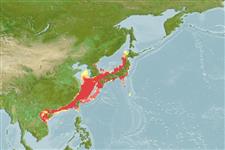Elasmobranchii (hajar och rockor) (sharks and rays) >
Myliobatiformes (Stingrays) >
Myliobatidae (Eagle and manta rays)
Etymology: Myliobatis: Greek, mylo = mill + Greek, + Greek, batis,-idos = a ray (Raja sp.) (Ref. 45335).
More on author: Bleeker.
Environment: milieu / climate zone / djupintervall / distribution range
Ekologi
marina bottenlevande; djupintervall 0 - 220 m (Ref. 9862). Tropical
Northwest Pacific: Russia, China, South Korea and Japan.
Size / Vikt / Age
Könsmognad: Lm ? range ? - ? cm
Max length : 150 cm TL hane/ej könsbestämd; (Ref. 9862)
This small species (attaining about 66.5 cm DW) has the following set of characters: colour of dorsal surfaces yellowish brown, usually with variable, irregular dark blotches; tail with a very weak ventral skin fold; stinging spine(s) are relatively long (longest spine 10.3-18.6% DW); interorbital space is shallowly concave in adult males; anterior margins of pectoral fins moderately convex; cranial fontanelle (visible in dorsal view without dissection) is relatively narrow with mostly straight lateral margins; claspers of adult males 6.6-10.2% DW; predorsal length 66.6-78.8% DW; each jaw with 7 rows of teeth, with a broad median row flanked by three smaller rows on each side; pectoral-fin radials 79-85 (excluding rostral propterygial radials anterior of the eyes); total vertebral centra (including synarcual) 115-124; males mature by 42.9 cm DW (Ref. 132213).
Cross section: flattened.
Found from the intertidal to the uppermost continental slope (Ref. 9862, 11230). A carnivore feeding on benthic animals. Ovoviviparous (Ref. 50449). Males and females ranged in size from 24.5-61.9 and 21.4-65.6 cm DW, respectively. Five males between 42.9 and 61.9 cm DW were found to be mature and a 41.0 cm DW male was adolescent, while 18 males between 24.5 and 32.3 cm DW were immature. A female of 65.6 cm DW was found pregnant. A reported abnormal female specimen was 66.5 cm DW and weighed 5.5 kg. The largest male examined was 61.9 cm DW had a total length of 125.7 cm (Ref. 132213).
Life cycle and mating behavior
Könsmognad | Reproduktion | Lek | Ägg | Fecundity | Larver
Exhibit ovoviparity (aplacental viviparity), with embryos feeding initially on yolk, then receiving additional nourishment from the mother by indirect absorption of uterine fluid enriched with mucus, fat or protein through specialised structures (Ref. 50449).
White, W.T., J. Kawauchi, S. Corrigan, E. Rochel and G.J.P. Naylor, 2015. Redescription of the eagle rays Myliobatis hamlyni Ogilby, 1911 and M. tobijei Bleeker, 1854 (Myliobatiformes: Myliobatidae) from the east Indo-West Pacific. Zootaxa 3948(3):521-548. (Ref. 132213)
IUCN Red List Status (Ref. 130435: Version 2025-1)
Threat to humans
Traumatogenic
Human uses
Fiskeri: mindre kommeriell; sportfisk: ja
Verktyg
Special reports
Download XML
Internet-källor
Estimates based on models
Preferred temperature (Ref.
123201): 12.8 - 24.7, mean 20.3 °C (based on 176 cells).
Phylogenetic diversity index (Ref.
82804): PD
50 = 0.5002 [Uniqueness, from 0.5 = low to 2.0 = high].
Bayesian length-weight: a=0.00389 (0.00119 - 0.01269), b=3.08 (2.83 - 3.33), in cm total length, based on LWR estimates for this (Sub)family-body shape (Ref.
93245).
Trofisk nivå (Ref.
69278): 3.5 ±0.37 se; based on food items.
Resiliens (Ref.
120179): Låg, lägsta populationsfördubblingstid 4,5-14 år (Fec assumed to be <100).
Fishing Vulnerability (Ref.
59153): Very high vulnerability (90 of 100).
🛈
